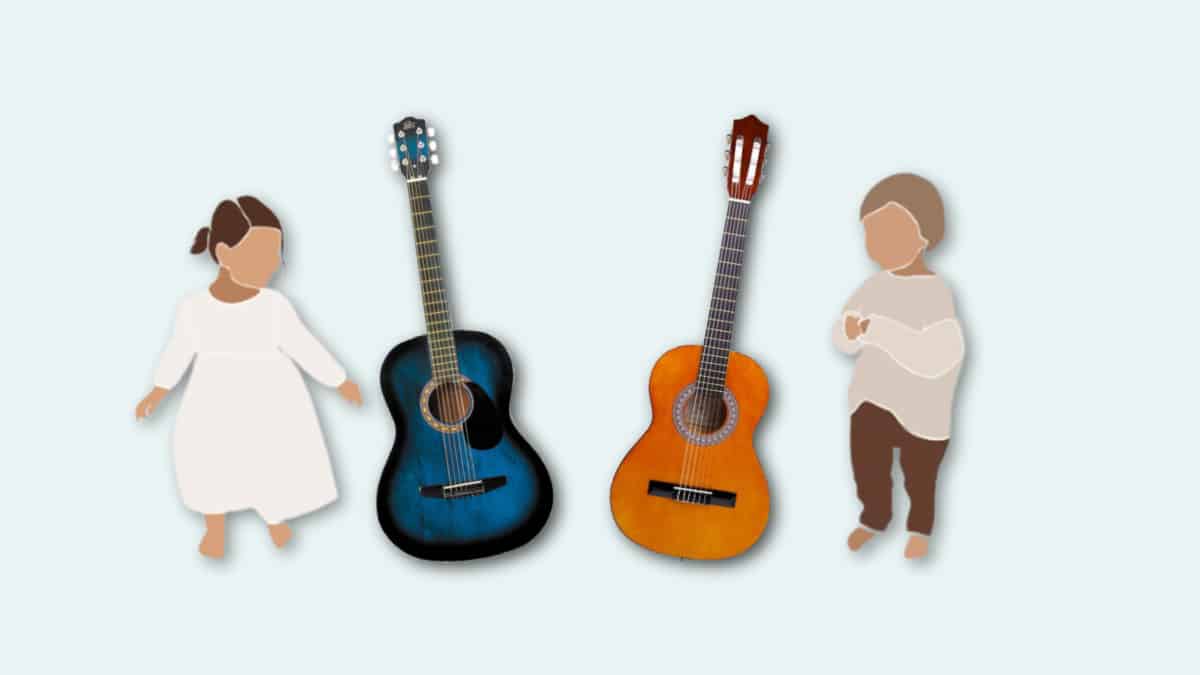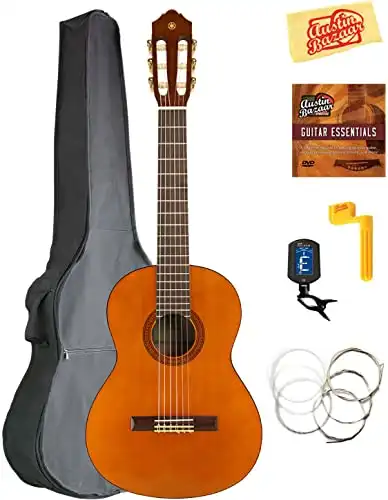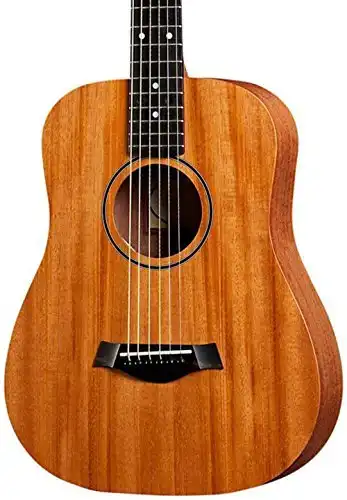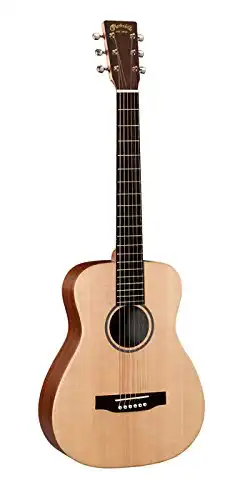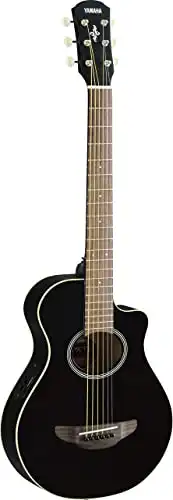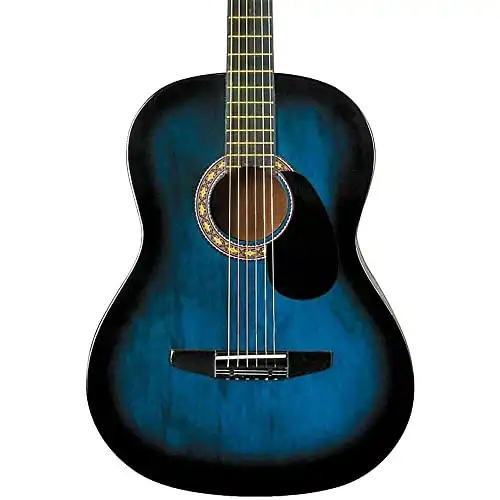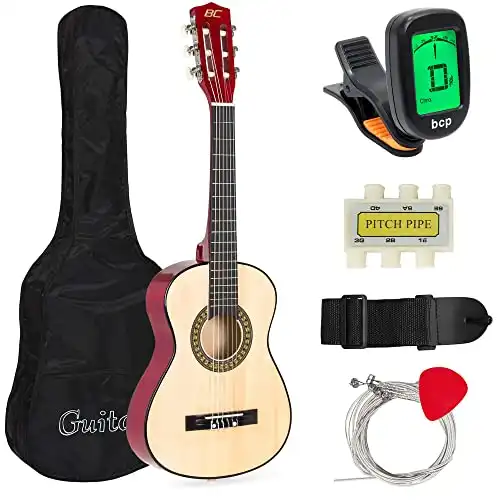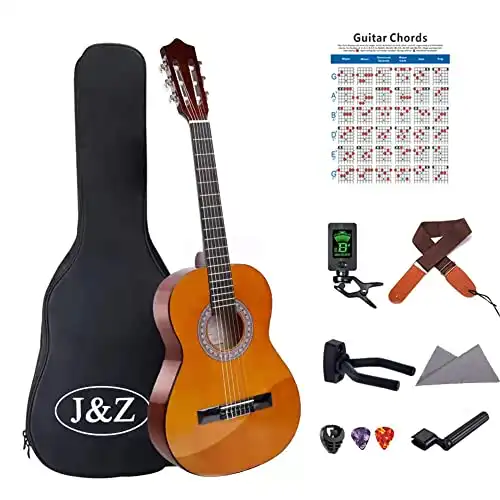Wanna cut to the chase? I went searching for the best beginner acoustic guitar for kids, and my top pick (for about ages 6-10) was the Yamaha CGS102A Half-Size Classical Bundle. For older kids, my top pick was the Baby Taylor BT2.
Learning the guitar as a teenager opened the door to many interesting experiences and friendships that could’ve missed out on otherwise.
I’d recommend learning the guitar for any kid. Not only can it be a rewarding hobby, but it’s great for their mental development, and physical coordination as well.
Unfortunately, finding a good beginner guitar for your child can be tricky.
You’ll have to pay close attention to the size, style, and ease of play for whatever guitar you get.
You should also consider the age, physical stature, and motivation of your child, and have a plan for how they will learn to play.
Today I’ll go over over some key questions to consider, followed by a list of specific guitars to help you find the best fit for your child.
How to choose a guitar for a child
Buying a guitar for a child is a little bit more complicated than buying one for an adult.
Here are some important things to keep in mind when buying guitars for kids.
Can a four-year-old play guitar?
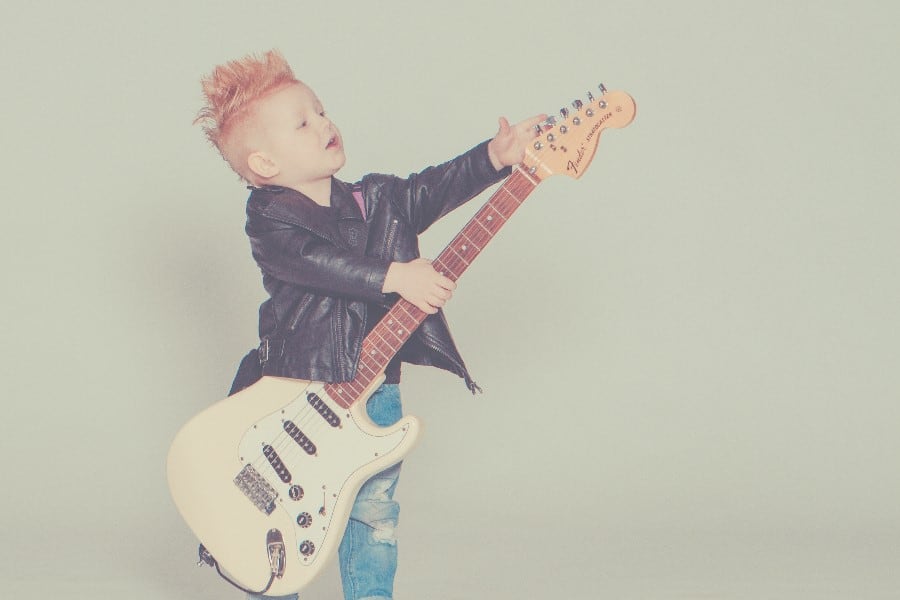
People often ask at what age children can (or should) start learning guitar.
The answer depends on a lot of things, but I wouldn’t recommend starting any younger than 5 years old.
Much younger than that and they probably won’t have the physical size or strength that they need to push the strings down or strum a guitar (and even a 5-year-old may struggle).
Ultimately, it’s probably easier if you wait till they’re a few years older (say, 8-10), with a longer reach, stronger hands, and a little more mental maturity.
An older child will probably also be more decisive and more willing to commit to practicing for months or years to come.
I didn’t learn guitar until I was 18 (my parents had me take piano lessons instead). I kind of wish I started younger, but at the same time I may not have been interested enough to stick with it.
What size guitar is good for a 5 year old, 7 year old, 9 year old, etc?
If you do decide to have your child learn guitar at a young age, the most important thing is not to get a guitar that’s too big for them.
For example, a five-year-old playing an adult size guitar wouldn’t be able to reach all the way to the end of the fingerboard, nor comfortably reach their arm over the body of the guitar to strum it.
Instead, a small child needs a guitar with a short and narrow neck so they can reach all the finger positions.
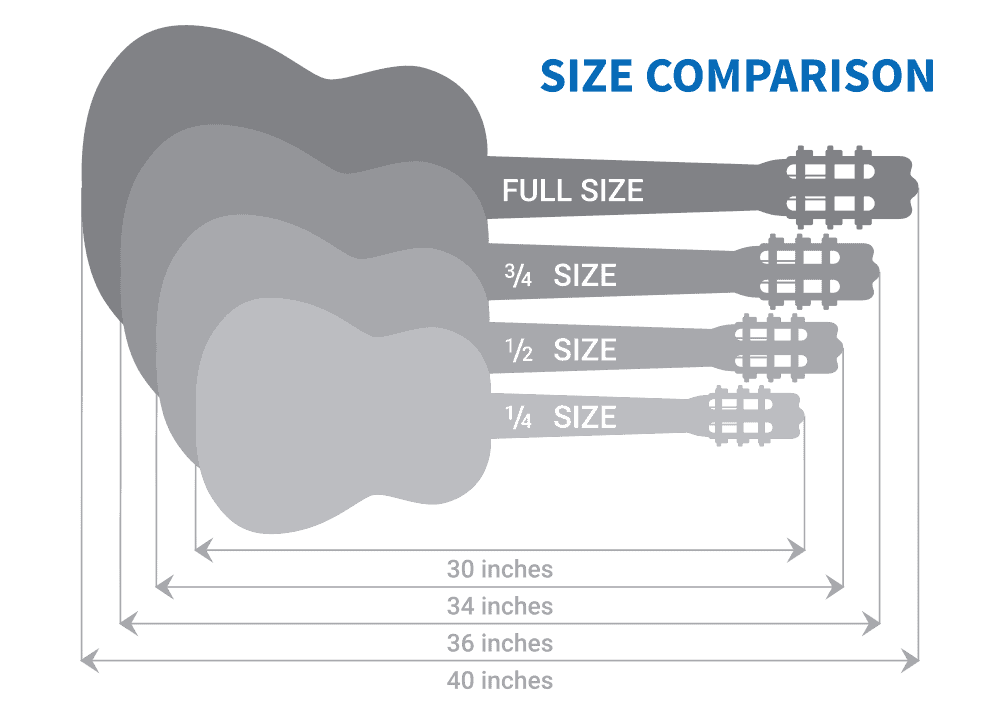
Smaller guitar sizes that work for children are often referred to as 1/4, 1/2, 3/4, or 7/8 of a full-size guitar (see image above).
The table below gives you a rough idea how these guitar sizes match up with the age of your child (but also consider how big or small they are for their age).
| Guitar Size | Overall Length | Approximate Age |
| 1/4 | 30’’ | 4-8 |
| 1/2 | 34’’ | 6-10 |
| 3/4 | 36’’ | 10 and up |
| Full size | 40’’ | 14 and up |
Should I get an acoustic guitar for my kid?
In most cases, yes. Children’s acoustic guitars are simpler than electric, with less equipment to store or keep track of (or break).
Acoustic guitars are also usually less expensive (though this obviously depends on exactly which one you buy).
Electric guitars do have some advantages. For instance, the strings are pretty easy to push down and your kid can wear headphones when they practice if no one else wants to hear.
But overall, considering the various pros and cons, I generally recommend a small folk / classical guitar with nylon strings for a kid who is just starting out.
Nylon strings are easier and more comfortable to play, so your kid’s fingers won’t get as sore, callused, or “numb” as they would with steel strings.
They also won’t need to plug anything in or manage all the equipment that comes with an electric guitar.
To help you out, I’ve included a few folk / classical guitars (with nylon strings) in the reviews section below.
What else makes a good beginner guitar for a child?
Besides choosing a right-sized guitar and strings that are easy to push down, guitar “action” is also something to keep an eye on.
The action is the space between the strings and the fingerboard (or how far you have to push the string down to make a note).
Ideally you want a guitar with low action for any beginner, especially a child.
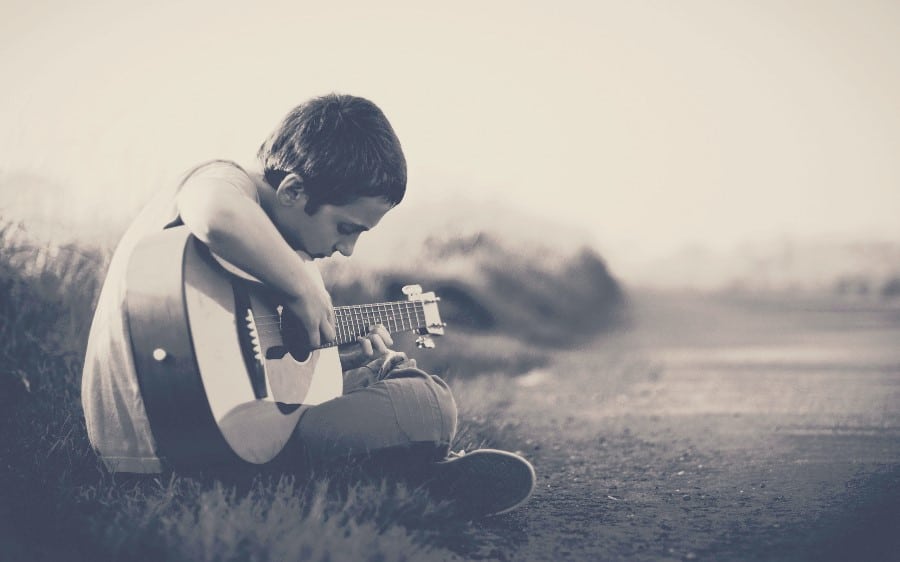
Keep in mind that if you don’t like the action on your new guitar, you can usually have it adjusted in a guitar shop for a fee (maybe $50-$100).
Some people recommend doing this for every new guitar, as the action from the factory can vary quite a bit, even for the same model.
Also consider using a thinner (light gauge) strings over thicker (heavy gauge) strings when just starting out. Leave the thicker guitar strings to the players with the already callused fingers 🙂
Should I get a kids starter guitar, or something nicer?
Unless you enjoy blowing a bunch of cash, you should probably start with something fairly inexpensive for your child’s first guitar.
Try to find a guitar that’s just nice enough to sound decent and be easy to play, but not so expensive you’ll regret buying it if you find that it’s collecting dust in a corner a few months later.
In my reviews, I’ll highlight a few inexpensive starter options, as well as some upgrades for kids who are a bit more motivated or advanced.
Do I need a “starter bundle”?
It’s kind of nice if your guitar comes with a tuner, capo, strings, picks, or other accessories, but it’s definitely not a necessity.
All you really need is a few picks, an extra set of strings (in case one of them breaks), and somewhere to put the guitar when you’re not using it (either a case / bag or a display stand).
There are plenty of tuner apps you can use on your phone, and you can pick up other accessories down the road if you find that you actually need them.
On the other hand, the starter bundle may only cost an extra $20 or $30, so if you’d rather have that convenience then it’s not a big deal.
Should my child take guitar lessons?
If you’re going to spend the money on a guitar for your child, you should probably also have a plan to help them learn how to play.
These days, there are plenty of free lessons on YouTube and similar platforms. Some videos teach scales, some teach chords, and others teach specific songs.
I think the simplest and funnest way to start is to learn a few basic chords, and use those chords to learn at least one easy song.
For example, if your kid learns the G major, C major, and D major chords, they could use those to play an easy song like Leaving on a Jet Plane (as demonstrated in the video below).
This was one of the first songs I learned on the guitar, and it’s also fun to sing along with.
Your child would only need to learn one or two additional chords to play a variety of more modern songs (from artists like Adele or Taylor Swift, for example).
They could also try to learn the blues, which lets them start improvising right away with just a few chords.
If you’d rather use an online platform (and a more organized approach) to learn, one popular option with a bunch of free lessons is Justin Guitar. There are several other websites and other places with free lessons as well.
There are also plenty of individual teacher websites. And Lecture Owl is a site that connects you with several professional teacher profiles.
Finding teachers in person is fairly easy as well. You might try asking your friends, but you can also browse profiles and read reviews on sites like Thumbtack or TakeLessons.
How to keep your child motivated
Ideally, you want to keep things simple and fun at the beginning.
One way to do this is to start with just a few minutes of practice each day. This could be as short as three to five minutes, at the beginning.
You’ll gradually increase from there, but starting with something super simple and easy will make them more likely to establish a habit.
Set some type of reminder, like an alarm on your phone, and have them try to do it around the same time everyday.
And again, to make it more fun, try to make sure they have the opportunity to learn at least one song they are familiar with in the first few days of lessons / practice.
REVIEWS: Best Beginner Acoustic Guitars for Kids
Now that you know the most important things to consider when getting a guitar for a child, let’s look at some specific options..
Top Pick ages 6-10: Yamaha CGS102A Half-Size Classical Guitar Bundle
This half-size classical guitar from Yamaha seems like a good fit for kids in the 6 to 10 year old range (or an adult with very small hands).
It has low action and soft nylon strings, which will make it easy for a child to play.
The overall sound is very good, and it tends to stay in tune quite well.
This guitar comes with all the basic accessories and an instructional DVD, so you don’t necessarily need to buy anything else (though the soft case may be looser than you’d like).
One drawback is the lack of an electric pickup (to amplify the sound), but a kid who is just starting out probably won’t need this.
It also doesn’t have a “cutaway” shape (which would make it easier to reach really high notes), but most beginners don’t need that either.
Overall, this looks like an excellent value for the money, which is why I think it’s the best beginner guitar for a child, ages 6 to 10.
What I Like
- Reasonable price
- Easy to play (nylon strings and low action)
- Includes a starter pack
- Good overall sound
- Good fit for about 6-10 years old
What I Don’t Like
- No electric pickup
- Not a cutaway
- Gig bag may be too loose
Top Pick for Older Kids: Taylor BT2 Baby Taylor Acoustic Guitar
This “baby” Taylor guitar is slightly larger than a 3/4 size, so it’s probably a better fit for an older kid (about 11 and up), rather than a young child.
It’s a little more pricey, so not necessarily the first guitar to get if you’re just testing the waters.
The steel strings are not as easy on the fingers (compared to nylon strings), but it does have low action, which means the strings are easy to push down.
It has incredible sound and stays in tune very well. It’s also quite loud for its size.
There’s no electric pickup, so make sure you won’t be needing to “plug in” for a performance or jam session.
Overall this is an excellent value, which is why it’s my top upgrade pick for a kid about age 11 or older.
What I Like
- Amazing sound
- Excellent quality
- Low action (easy to play)
- Comes with a nice gig bag
- Good fit for about age 11 and up
What I Don’t Like
- No starter bundle
- No electric pickup (can’t use an amp)
- Not a cutaway (harder to reach high notes)
Martin LX1 Little Martin Acoustic Guitar
Like the Taylor above, this “little” Martin is on the larger end of what we would call a kid’s guitar, so I would probably reserve it for about ages 12 and up.
It has a beautiful, rich tone, with bright-sounding steel strings.
The action is typically low and easy to play out of the box (although one reviewer had the action adjusted at a shop).
A nicely padded soft case (or gig bag) is included.
There’s no electric plug-in, so you can’t use it with an amp. It also doesn’t have a cutaway, so it can be harder to reach the high notes (closer to the sound hole).
While it’s not the cheapest guitar on the list, it does appear to be a solid value for the money.
I’d recommend this guitar If you’re looking for a high-quality steel string guitar for someone at least 12 years old.
What I Like
- Beautiful sound
- Low action (easy to play)
- Comes with a nice gig bag
- Good fit for a teenager or small adult
What I Don’t Like
- No starter bundle
- No electric pickup / plugin
- Not a cutaway
Top Acoustic-Electric: Yamaha APXT2 3/4-Size Acoustic-Electric Guitar
The Yamaha APXT2 3/4-Size Acoustic-Electric Guitar has a unique and attractive body shape and comes in several different finishes and colors so you can pick a style that best suits you. Personally, I love the versatility of this acoustic-electric guitar, and the built-in tuner and cutaway make it extra convenient.
Note: I also included this guitar in my Best Yamaha Acoustic Guitars review article.
This is a 3/4 size acoustic-electric guitar with a fairly shallow body.
The smaller body size makes it easy to hold, so it’s probably a good fit for about 8 years of age and up.
When I tried it out, the strings were pretty easy to push down. The sound was decent, but also slightly “tinny” (likely because of the small body size).
This is the only acoustic-electric I reviewed in this article, since kids don’t usually need to plug in to an amp, but if that’s something you’re looking for this may be a good (and affordable) option.
It’s also a cutaway, which is nice for playing higher notes.
If you’re looking for a reasonably priced guitar with an electric pickup and a cutaway body shape, then this is a good option.
What I Like
- Inexpensive
- Acoustic-Electric
- Cutaway
- Good fit for about 8 years old and up
What I Don’t Like
- Somewhat hollow sound
- No starter bundle
The Yamaha APXT2 3/4-Size Acoustic-Electric Guitar has a unique and attractive body shape and comes in several different finishes and colors so you can pick a style that best suits you. Personally, I love the versatility of this acoustic-electric guitar, and the built-in tuner and cutaway make it extra convenient.
Rogue Starter Acoustic Guitar Blue Burst
The Rogue Starter is a popular option largely due to its attractive appearance and modest price.
The deep, rich colors will keep kids interested, and may impress their friends.
The fingerboard is almost full length (⅞), so it’s not too cramped even for older kids.
The body is fairly small, however, so younger kids (say, 9 and up) probably won’t have too much trouble holding it.
The sound is decent, but not the best you will find.
Overall, this can be a fun starter guitar for about ages 9 and up that may help hold your kids interest and get them to practice more.
What I Like
- Unique, attractive appearance
- Versatile size works for various ages
What I Don’t Like
- Sound could be better
- No starter bundle
- No electric pickup
Best Choice 30 in Classical Acoustic Guitar Beginners Set
If you’re looking for an ultra-budget option for a very young child, this may be the guitar for you.
It’s definitely not high quality, but just playable enough to be an okay starter guitar.
The sound won’t be great, But since it costs about the same as a toy, it’s still a reasonable deal.
It’s about 1/4 size, so probably fits kids in about the 4 to 8 year old range.
It does come with the starter bundle, so you’ll have a tuner, strap, picks, and a carrier bag.
I would only recommend this guitar if you’re strapped for cash and just looking for a super basic starter guitar for a young child.
What I Like
- Budget option!
- Small, suitable for ages 4-8
- Includes a starter bundle
- Various color options
What I Don’t Like
- Not the highest quality
- Sound could be much better
Classical ¾-Size Kids Acoustic Guitar with Starter Bundle
This J&Z junior-size guitar is a great beginner's option for kids. It comes with various accessories, including a guitar polishing wipe and a waterproof gig bag, giving your child the essentials they need to learn how to look after their guitar from the start.
This is a 3/4 size classical acoustic guitar, which makes it suitable for about ages 9 and up.
The quality is higher than you might expect for the price, and the sound quality is pretty decent.
The nylon strings are easy to play, making it a good option for a kid who’s just starting out.
It comes with a starter pack (tuner, picks, strap, bag), so you may not need to buy any other accessories.
Overall, this is a budget option that still has decent quality, which is why I’d recommend it as my top budget option for a beginner kids guitar, age 9 and up.
What I Like
- Very affordable
- Nylon strings – easy to play
- ¾ size, suitable for ages 10-14
- Includes a starter bundle
What I Don’t Like
- No electric pickup / plugin
- Not a cutaway
- Sound could be better
- Doesn’t always stay in tune
This J&Z junior-size guitar is a great beginner's option for kids. It comes with various accessories, including a guitar polishing wipe and a waterproof gig bag, giving your child the essentials they need to learn how to look after their guitar from the start.
Conclusion
Playing the guitar is an awesome skill for a child to learn because it’s lots of fun, great for development, and can lead to a rewarding lifelong hobby.
Children can start learning guitar at any age, but it’s easier if they wait till about 8 years old, as they’re a bit stronger and more mature.
Whatever age your child is starting at, the most important thing is not to get a guitar that’s too big for them to hold or play.
I generally recommend a classical acoustic guitar with nylon strings as the best beginner acoustic guitar for children, because they’re usually quite affordable and easy to play.
Make sure you have some type of plan for how your child will learn the guitar. This could be as simple as a YouTube playlist, but some children may respond better to a more organized teaching plan, whether online or in person.
Make sure you keep things simple and fun so they’ll enjoy themselves and stay motivated.
After reviewing various guitars, my top overall pick was the Yamaha CGS102A Half-Size Classical Bundle (for about ages 6-10), because it’s reasonably priced and easy to play.
For older kids, my top pick was the Baby Taylor BT2, because it has great sound quality, which will help keep a teenager motivated.
Whatever guitar you choose for your child, I hope you and your child will experience the joy of music for years to come.
Thanks for visiting!

